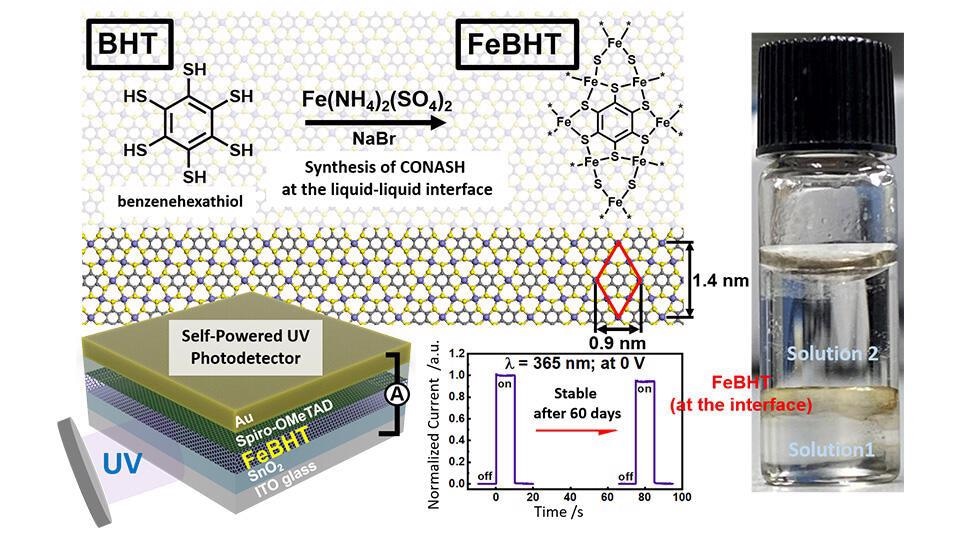Two-dimensional “nanosheets” formed of bonds between metal atoms and organic molecules are considered to be appealing candidates for photoelectric conversion but tend to get corroded easily.
 Scientists from Japan and Taiwan designed a nanosheet material using iron and benzene hexathiol that made for a high-performance self-powered UV photodetector with a record current stability after 60 days of air exposure. Image Credit: Hiroshi Nishihara from Tokyo University of Science.
Scientists from Japan and Taiwan designed a nanosheet material using iron and benzene hexathiol that made for a high-performance self-powered UV photodetector with a record current stability after 60 days of air exposure. Image Credit: Hiroshi Nishihara from Tokyo University of Science.
As part of a new study, researchers from Japan and Taiwan have created a new nanosheet design made of iron and benzene hexathiol that shows the highest stability to air exposure for around 60 days, thereby indicating the commercial optoelectronic applications of such 2D materials in the future.
In the field of optoelectronics, one of the main goals of researchers is to effectively convert light to electricity. While it has been difficult to enhance the conversion efficiency, various other needs should also be fulfilled. For example, the material should conduct electricity well and exhibit a short response time to variations in input (light intensity), while mainly being firm under long-term exposure.
Researchers have recently been surprised by “coordination nanosheets” (CONASHs) — organic-inorganic hybrid nanomaterials where organic molecules are bonded to metal atoms in a 2D network.
The attention toward CONASHs is primarily due to their potential to absorb light at multiple wavelength ranges and transform them into electrons with higher efficiency compared to other kinds of nanosheets.
This was evidenced in a CONASH containing a zinc atom bonded with a porphyrin-dipyrrin molecule. However, the CONASH corroded rapidly as a result of the low stability of organic molecules present in liquid electrolytes (a medium generally utilized for current conduction).
The durability issue needs to be solved to realize the practical applications of CONASH-based photoelectric conversion systems.
Hiroshi Nishihara, Professor, Tokyo University of Science
Nishihara performs studies on CONASH and has been trying to resolve the CONASH stability issue.
In a recent study published in the journal Advanced Science, Prof. Nishihara and his collaborators, Dr. Hiroaki Maeda and Dr. Naoya Fukui from TUS, Dr. Ying-Chiao Wang and Dr. Kazuhito Tsukagoshi from NIMS, Mr. Chun-Hao Chiang and Professor Chun-Wei Chen from National Taiwan University, Taiwan, and Dr. Chi-Ming Chang and Prof Wen-Bin Jian from National Chiao-Tung University, Taiwan, developed a CONASH containing an iron (Fe) ion bonded to a benzene hexathiol (BHT) molecule that has shown the highest stability under air exposure reported to date.
The research was a collaborative one between National Institute for Materials Science (NIMS), Japan and TUS. The new FeBHT CONASH-based photodetector has the ability to retain more than 94% of its photocurrent following 60 days of exposure. Furthermore, the device does not need any external power source.
The study tries to find the reason behind the possibility of such a feat. The researchers made some smart choices. First, they chose an all-solid architecture by substituting the liquid electrolyte with a solid-state layer of Spiro-OMeTAD, an efficient transporter of “holes” (vacancies leftover by electrons).
Second, the researchers produced the FeBHT network by making iron ammonium sulfate react with BHT, which helped achieve two things: the reaction was adequately slow to retain the sulfur group safeguarded from being oxidized, and it enabled the resultant FeBHT network to become resistant to oxidation, as the researchers verified with the help of density functional theory calculations.
Moreover, the FeBHT CONASH exhibited high electrical conductivity, improved photoresponse with a conversion efficiency of 6% (the highest efficiency reported earlier was 2%) and a response time of <40 ms for UV light illumination.
Thanks to these findings, the researchers are eagerly looking forward to the potential of CONASH in commercialized optoelectronic applications.
The high performance of the CONASH-based photodetectors coupled with the fact that they are self-powered can pave the way for their practical applications such as in light-receiving sensors that can be used for mobile applications and recording the light exposure history of objects.
Hiroshi Nishihara, Professor, Tokyo University of Science
Journal Reference:
Wang, Y.-C., et al. (2021) Two-Dimensional Bis(dithiolene)iron(II) Self-Powered UV Photodetectors with Ultrahigh Air Stability. Advanced Science. doi.org/10.1002/advs.202100564.